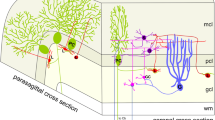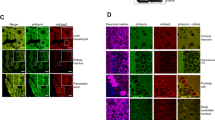Abstract
Phospholipase A2 (PLA2) is a family of enzymes playing diverse roles in lipid signaling in neurons and glia cells. In this study, we examined the expression of subtypes of PLA2 in the cerebellum using immunolabeling and in situ hybridization methods. Two Ca2+-dependent cytosolic subtypes (cPLA2α and cPLA2β), one Ca2+-independent cytosolic subtype (iPLA2), and two secretory subtypes (sPLA2IIA and sPLA2V) were detected in the cerebellum. cPLA2α is present in somata and dendrites of Purkinje cells, while sPLA2IIA is associated with the endoplasmic reticulum in perinuclear regions of Purkinje cell somata. iPLA2 is present in granule cells, stellate cells and also in the nucleus of Purkinje cells. In addition, cPLA2β is localized in granule cells, and sPLA2V in Bergmann glia cells. These results provide an important basis for identifying functional roles of PLA2s in the cerebellum.
Similar content being viewed by others
References
AKIBA, S., MIZUNAGA, S., KUME, K., HAYAMA, M. & SATO, T. (1999) Involvement of group VI Ca 2-independent phospholipase A2 in protein kinase C-dependent arachidonic acid liberation in zymosan-stimulated macrophage-like P388D1 cells. Journal of Biological Chemistry 274, 19906–19912.
AKIBA, S., OHNO, S., CHIBA, M., KUME, K., HAYAMA, M. & SATO, T. (2002) Protein kinase C-dependent increase in Ca 2-independent phospholipase A2 in membranes and arachidonic acid libration in zymosan-stimulated macrophage-like P388D1 cells. Biochemical Pharmacology 63, 1969–1977.
ATSUMI, G.-I., TAJIMA, M., HADANO, A., NAKATANI, Y., MURAKAMI, M. & KUDO, I. (1998) Fas-induced arachidonic acid release is mediated by Ca 2-independent phospholipase A2 but not cytosolic phospholipase A2, which undergoes proteolytic inactivation. Journal of Biological Chemistry 273, 13870–13877.
AUSUBEL, F. M., BRENT, R., KINGSTON, R. E., MOORE, D. D., SEIDMAN, J. G., SMITH, J. A. & STRUHL, K. (1997) Current Protocols in Molecular Biology. New York: Wiley
BINGHAM III, C. O., FIJNEMAN, R. J. A., FRIEND, D. S., GODDEAU, R. P., ROGERS, R. A., AUSTEN, K. F. & ARM, J. P. (1999) Low molecular weight group IIA and group V phospholipase A2 enzymes have different intra-cellular locations in mouse bone marrow-derived mast cells. Journal of Biological Chemistry 274, 31476–31484.
BONVENTRE, J. V. (1992) Phospholipase A2 and signal transduction. Journal of American Society for Nephrology 3, 128–150.
BONVENTRE, J. V., HUANG, Z., TAHERI, M. R., O'LEARY, E., LI, E., MOSKOWITZ, M. A. & SAPIRSTEIN, A. (1997) Reduced fertility and postis-chemic brain injury in mice deficient in cytosolic phospholipase A2. Nature 390, 622–625.
CHOMCZYNSKI, P. & SACCHI, N. (1987) Single-step method of RNA isolation by acid guanidinium thiocyanate-phenol-chloroform extraction. Analytical Biochemistry 162, 156–159.
HIRONO, M., SUGIYAMA, T., KISHIMOTO, Y., SAKAI, I., MIYAZAWA, T., KISHIO, M., INOUE, H., NAKAO, K., IKEDA, M., KAWAHARA, S., KIRINO, Y., KATSUKI, M., HORIE, H., ISHIKAWA, Y. & YOSHIOKA, T. (2001) Phospholipase C 4 and protein kinase C and/or protein kinase C I are involved in the induction of long term depression in cerebellar Purkinje cells. Journal of Biological Chemistry 276, 45236–45242.
HO, I-C., ARM, J. P., BINGHAM III, C. O., CHOI, A., AUSTEN, K. F. & GLIMCHER, L. H. (2001) A novel group of phospholipase A2s preferentially expressed in type 2 helper T cells. Journal of Biological Chemistry 276, 18321–18326.
ITO, M. (2001) Cerebellar long-term depression: Characterization, signal transduction, and functional roles. Physiological Reviews 81,1143–1195.
ITO, M. (2002) The molecular organization of cerebellar long-term depression. Nature Reviews Neuroscience 3, 896–902.
JACOBSON, P. B., MARSHALL, L. A., SUNG, A. & JACOBS, R. S. (1990) Inactivation of human synovial fluid phospholipase A2 by the marine natural product, manoalide. Biochemical Pharmacology 39, 1557–1564.
KATAOKA, Y., MORII, H., WATANABE, Y. & OHMORI, H. (1997) A postsynaptic excitatory amino acid transporter with chloride conductance functionally regulated by neuroral activity in cerebellar Purkinje cells. Journal of Neuroscience 17, 7017–7024.
KISHIMOTO, K., MATSUMURA, K., KATAOKA, Y., MORII, H. & WATANABE, Y. (1999) Localization of cytosolic phospholipase A2 messenger RNA mainly in neurons in the rat brain. Neuroscience 92, 1061–1077.
KURODA, S., SCHWEIGHOFER, N. & KAWATO, M. (2001) Exploration of signal transduction pathways in cerebellar long-term depression by kinetic simulation. Journal of Neuroscience 21, 5693–5702.
LARSSON, P. K. A., CLAESSON, H.-E. & KENNEDY, B. P. (1998) Multiple splice variants of the human calcium-independent phospholipase A2 and their effect on enzyme activity. Journal of Biological Chemistry 273, 207–214.
LARSSON FORSELL, P. K. A., KENNEDY, B. P. & CLAESSON, H.-E. (1999) The human calcium-independent phospholipase A2 gene: Multiple enzymes with distinct properties froma single gene. European Journal of Biochemistry 262, 575–585.
LEV-RAM, V., NEBYELUL, Z., ELLISMAN, M. H., HUANG, P. L. & TSIEN, R. Y. (1997) Absence of cerebellar long-term depression in mice lacking neuronal nitric oxide synthase. Learning and Memory 3, 169–177.
LIANG, Y., HARING, M., ROUGHLEY, P. J., MARGOLIS, R. K. & MARGOLIS, R. U. (1997) Glypican and biglycan in the nuclei of neurons and glioma cells: Presence of functional nuclear localization signals and dynamic changes in glypican during the cell cycle. Journal of Cell Biology 139, 851–864.
LIN, L.-L., WARTMANN, M., LIN, A. Y., KNOPF, J. L., SETH, A. & DAVIS, R. J. (1993) cPLA2 is phosphorylated and activated by MAP kinase. Cell 72, 269–278.
LINDEN, D. J. (1995) Phospholipase A2 controls the induction of short-term versus long-term depression in the cerebellar Purkinje neuron in culture. Neuron 15, 1393–1401.
MURAKAMI, M., SHIMBARA, S., KAMBE, T., KUWATA, H., WINSTEAD, M. V., TISCHFIELD, J. A. & KUDO, I. (1998) The functions of five distinct mammalian phospholipase A2s in regulating arachi-donic acid release: Type IIA and type V secretory phospholipase A2s are functionally redundant and act in concert with cytosolic phospholipase A2. Journal of Biological Chemistry 273, 14411–14423.
MURAKAMI, M., KAMBE, T., SHIMBARA, S., YAMAMOTO, S., KUWATA, H. & KUDO, I. (1999) Functional association of type IIA secretory phospholipase A2 with the glycosylphosphatidylinositol-anchored heparan sulfate proteoglycan in the cyclooxygenase-2-mediated delayed prostanoid-biosynthetic pathway. Journal of Biological Chemistry 274, 29927–29936.
MURAKAMI, M., NAKATANI, Y., KUWATA, H. & KUDO, I. (2000) Cellular components that functionally interact with signaling phospholipase A2s. Biochimica et Biophysica Acta 1488, 159–166.
MURAKAMI, M. & KUDO, I. (2002) Phospholipase A2. Journal of Biochemistry 131, 285–292.
NISHIZUKA, Y. (1992) Intracellular signaling by hydrolysis of phospholipids and activation of protein kinase C. Science 258, 607–614.
PICKARD, R. T., STRIFLER, B. A., KRAMER, R. M. & SHARP, J. D. (1999) Molecular cloning of two new human paralogs of 85-kDa cytosolic phospholipase A2. Journal of Biological Chemistry 274, 8823–8831.
SHIBUKI, K., GOMI, H., CHEN, L., BAO, S., KIM, J.J., WAKATSUKI, H., FUJISAKI, T., FUJIMOTO, K., KATOH, A., IKEDA, T., CHEN, C., THOMPSON, R.F. & ITOHARA, S. (1996) Deficient cerebellar long-term depression, impaired eyeblink conditioning, and normal motor coordination in GFAP mutant mice. Neuron 16, 587–599.
SHINZAWA, K. & TSUJIMOTO, Y. (2003) PLA2 activity is required for nuclear shrinkage in caspase-independent cell death. Journal of Cell Biology 163, 1219–1230.
UOZUMI, N., KUME, K., NAGASE, T., NAKATANI, N., ISHII, S., TASHIRO, F., KOMAGATA, Y., MAKI, K., IKUTA, K., OUCHI, Y., MIYAZAKI, J.-I. & SHIMIZU, T. (1997) Role of cytosolic phospholipase A2 in allergic response and parturition. Nature 390, 618–621.
WILKINSON, D. G. (1992) In Situ Hybridization: APractical Approach. London: Oxford University Press
YANG, H.-C., MOSIOR, M., NI, B. & DENNIS, E. A. (1999a) Regional distribution, ontogeny, purification, and characterization of the Ca 2-independent phospholipase A2 from rat brain. Journal of Neurochemistry 73, 1278–1287.
YANG, H.-C., MOSIOR, M., JOHNSON, C. A., CHEN, Y. & DENNIS, E. A. (1999b) Group-specific assays that distinguish between the four major types of mammalian phospholipase A2. Analytical Biochemistry 269, 278–288.
Author information
Authors and Affiliations
Rights and permissions
About this article
Cite this article
Shirai, Y., Ito, M. Specific differential expression of phospholipase A2 subtypes in rat cerebellum. J Neurocytol 33, 297–307 (2004). https://doi.org/10.1023/B:NEUR.0000044191.83858.f7
Issue Date:
DOI: https://doi.org/10.1023/B:NEUR.0000044191.83858.f7




